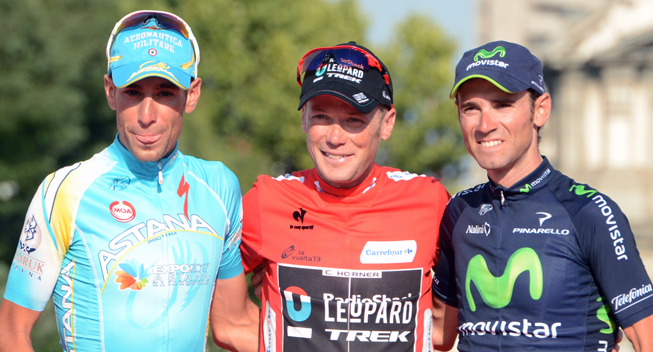Another new climb is likely to feature in the 2014 edition of the Vuelta a Espana. Spanish newspaper Diario de Navarra reports that a stage in the early part of the race will finish on the San Miguel de Aralar climb which is 11km long, has an average gradient of 8,05% and a maximum of 17% and is paved with cement.
The course for the Vuelta a Espana will be presented on January 11 but the Spanish press has already leaked many of the details of the 2014 edition of the Spanish grand tour. Today we can add another element to the picture as Diario de Navarra has revealed that organizers Unipublic and the government in Navarra have reached an agreement to have a stage finish on the San Miguel de Aralar climb.
The stage is said to be held in the early part of the race and is preceded by a day in the Aragon region and will be followed by one in La Rioja. The climb has a nice cement road, a length of 11km, an average gradient of 8,05% and steep ramps of as much as 17%. The steepest sections come inside the final kilometre which has an average gradient of 8,6%.
The new details can be added to what we already know about the Spanish grand tour. It has been reported that there will be fewer uphill finishes than in 2013, with the number being reduced from 11 to 8 or 9.
It has already been revealed that the race will kick on August 23 off in Jerez de la Frontera in the southern part of the country and the Spanish paper reports that the spectacle will be opened with a team time trial. From there the race will head north and east through Andalusia – where it will spend a week – Castilla-La Mancha and Aragon, but will avoid the Pyrenees, Catalonia and the Basque Country.
In recent years, the Vuelta a Espana has had a tradition of having three consecutive summit finishes in the third weekend of the race. According to the newspaper, this will be the case again in 2014.
The brutal triptych will start on Saturday, September 6 with a finish on the 9,8km La Camperona climb which has a three kilometre section where the gradient stays between 17% and 22%. Known as "the son of Angliru", it was tested by the Vuelta organizers earlier this year. If confirmed, the visit will be a first.
On Sunday, September 7, the race will continue with a summit finish on the legendary Lagos di Covadonga. Having been included 18 times since 1983, it is often visited by the Vuelta and was last climbed in 2012 when Antonio Piedra won from a breakaway.
On Monday, September 8, the riders will finish at the Lagos di Somiedo on the Farrapona climb. The finish was last used in 2011 when Rein Taaramae won from a breakaway while Juan Jose Cobo gave the first indications that he was the strongest rider in the race by finishing 2nd. The stage is likely to be a hard one and could include several other major ascents.
A rest day will precede the final week of the race that will include three or four stages in Galicia. While the third weekend will have a major impact on the GC, nothing will be decided until the very end. On the final Saturday, the riders will climb the Puerto de Ancares which has an average gradient of 9,25% and ramps of more than 20%. The climb was last included in 2012 when Joaquim Rodriguez and Alberto Contador battled fiercely for the race leadership, with the latter winning the stage. It is not yet guaranteed that it will be a summit finish.
As already reported, the race won't finish in Madrid in 2014. A time trial is likely to bring the race to a close in Santiago de Compostela but in contrast to earlier reports, it will not be held at nighttime. This will be the fourth time since Unipublic began organizing the Tour in 1979 that the race will finish outside the capital.
Chris Horner won this year's edition of the race and has stated his intention to defend his title in 2014.
| Charlotte COLCLOUGH 40 years | today |
| Sterre VERVLOET 21 years | today |
| Naser REZAVI 35 years | today |
| Noa JANSEN 24 years | today |
| Ramon CARRETERO 34 years | today |
© CyclingQuotes.com









